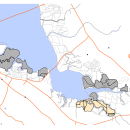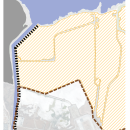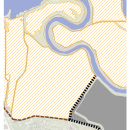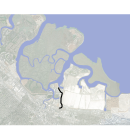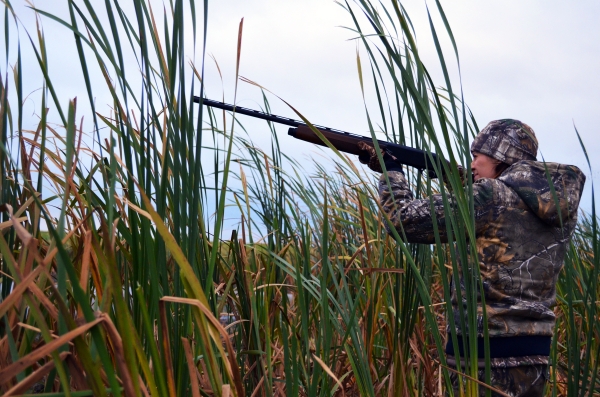
ALERT: Attention Hunters! Maintenance work in hunt ponds December 2024. PG&E has planned maintenance work on the following dates.
R1 - December 5-7
Greco Island - December 5-8 and December 10-11
Bair Island - December 10
A3N and A3W - December 18
All work will be conducted via helicopter access. Extreme weather conditions may cause rescheduling.
Waterfowl Hunting Program
General Information
The Don Edwards San Francisco Bay National Wildlife Refuge (refuge) contains approximately 10,580 acres of tidal areas and salt ponds that are open to waterfowl hunting (Map 1-Overview). Season opening and closing dates are determined by the State of California. Check the California Waterfowl Regulations each season for these dates. Hunters must comply with all State and Federal regulations including regulations listed under 50 CFR 32.24, and the refuge-specific regulations described below.
2024-2025 Season Dates - Balance of State Zone
Ducks: October 26 – January 31
Scaup: November 7 – January 31
Daily bag limit: 7/day, which may include: 7 mallards (no more than 2 females), 1 pintail, 2 canvasback, 2 redheads, 2 scaup. Possession limit is triple the daily bag.
Geese: Early Season (Large CAGO only): September 28 – September 30
Regular Season: October 26 – January 31.
Late Season: CAGO February 8 – 9. Whitefronts and white geese February 8 – February 12
Daily bag limit: 30/day, which may include: 20 white geese, 10 dark geese. Possession limit is triple the daily bag.
Youth Hunt Dates: February 1 – 2
Veteran and Active Military Personnel Dates: February 8 – 9
Daily bag limit: Same as regular season.
Shooting Time Tables
Permit Requirements
Hunters need to have:
1) California hunting license
2) Federal Duck Stamp (unless hunter is under the age of 16)
3) California Duck Validation (unless a Junior Hunter)
4)Harvest Information Program (HIP) Validation
5) identification that includes a photograph (e.g., driver’s license) - unless a Junior Hunter
Don Edwards San Francisco Bay National Wildlife Refuge Hunting Permit
It is required that all hunters possess a Don Edwards San Francisco Bay National Wildlife Refuge: 2024-2025 Waterfowl Hunting Permit when hunting in the Alviso Ponds. It is recommended that hunters also carry this permit when hunting in the Ravenswood Unit and Mowry ponds. The sloughs and open bay are subject to California Waterfowl Regulations and a refuge permit is not necessary
Hunting Areas
Alviso Ponds AB1, A2E, AB2, A3N, and A3W
- Located in South San Francisco Bay between Stevens Creek and Guadalupe Slough (Map 2 AB1-A3W)
- Hunting allowed on Wednesdays, Saturdays, and Sundays only
- Hunting is allowed from existing blinds only (Maps 3 AB1, A2E, AB2)and(Map 4 A3W, A3N). A boat or raft is needed to access these blinds and a boat ramp is located at the check station.
- Access to AB1, A2E, and AB2 is by motor vehicles from the end of Crittenden Lane in Mountain View
- Access to A3W and A3N is from the end of Carl Road in Sunnyvale (Please read “Driving Directions” on our website)
- No hunting from the levees - levees are shared with public trails
- No shooting allowed towards the adjacent levee trail (open to the public year-round)
Alviso Ponds A5, A7, and A8
- Located in South San Francisco Bay between Guadalupe Slough and Alviso Slough (Map 5. A5, A7, A8)
- Hunting allowed on Wednesdays, Saturdays, and Sundays only
- Access to ponds is from the Gold Street gate in Alviso (Please read “Driving Directions” on our website)
- Hunting from the levees is allowed (walking or bicycling on levees is allowed). Hunters must maintain a minimum distance of 300 feet from adjacent hunters when hunting on the levees.
- Hunting from a boat is allowed – blinds are not available in these ponds
- Hunters must shoot over Ponds A5/7/8 so not to interfere with adjacent hunt areas (in sloughs and nearby ponds)
Motorized vehicles on levees are not allowed (motorized bikes, ATVs, etc.) beyond the parking area
Alviso Pond A6 and A19
- Located near the Mowry Slough Unit in South San Francisco Bay between Mowry Slough and Coyote Creek
- Hunting is allowed seven days a week
- Access is by boat only—boats must access from the bay and hunt from the boat inside the pond
- Shooting from levees is prohibited
- No land or tidal marsh access is allowed, except to retrieve downed birds (due to endangered species present)
Ravenswood Ponds R1 and R2
- Located on the west side of the Dumbarton Bridge (parking along frontage road is available)
- Hunting is allowed seven days a week
- Hunting is allowed from the existing levees (top of levee to the toe of the levee) and from a boat
- Access to ponds is by foot or bicycle from either of two trailheads off Highway 84 (Map 6. Ravenswood)
- Hunting is prohibited within 300 feet of Highway 84 and the PG&E Substation
Bair Island and Greco Island
- Located on the west side of the San Francisco Bay, north of Dumbarton Bridge (Map 7. Bair Greco)
- Hunting is allowed seven days a week
- Hunting is allowed by boat in tidal areas (including Redwood Creek, Smith, Steinberger, and Corkscrew Sloughs). Be sure to check tides at the Bair Island Aquatic Center.
- No land or tidal marsh access is allowed, except to retrieve downed birds (due to endangered species present)
Mowry Ponds M1, M2, M3, M4, M5, M6
Although the refuge owns the Mowry Ponds and hunting is allowed, Cargill manages these ponds for salt production.
Due to an agreement between Cargill and FWS, Cargill has salt making rights in perpetuity on these ponds and FWS cannot impose any management regimes that would interfere with these salt rights. Therefore, the Mowry Ponds will be CLOSED to hunting when Cargill's "Mallard" dredge is present or any other levee maintenance activities are taking place (visible dozers, excavators, dump trucks, or graders). Our priority is to ensure safety of hunters, Cargill staff and refuge staff. However, if the “Mallard” or any other levee maintenance activities are not present or taking place within the Mowry Ponds, they will be open to hunting according to the following regulations:
- The Mowry ponds are only accessible from the sloughs and the Bay by boat (no land access)
- Hunting is allowed seven days a week
- Hunting is only allowed from a boat inside the ponds - hunting from the levees is NOT allowed
- No hunting is allowed with 300 feet of the Mowry Pond levees
- As with all salt ponds, tampering with water control structures is not allowed, for example: no opening/closing screw gates, no tampering with pumps or pump stations, no tampering with wooden gates, no attempt shall be made to manipulate brine levels, no access to walkways, boardwalks, pump station platforms, or any other infrastructure, no construction of any duck blinds, decks, docks, boat launching facilities, anchoring posts, etc., no digging on or into any levees
- These regulations will be strictly enforced and Refuge privileges may be revoked by the Refuge Manager or Refuge Officers for any alleged or suspected violation of these regulations.
- Hunters should be aware that Cargill employees, refuge staff, and other Cargill or refuge representatives may access the ponds at any time for any reason.
Tidal Areas
Tidal areas include salt marshes, sloughs, mudflats, and open water of San Francisco Bay. Unless posted in the field and/or noted below, all tidal areas in the refuge are open seven days a week to hunting from a boat, and only up to the mean high water line.
The following tidal areas are CLOSED to hunting and should be posted as “closed” in the field:
- Newark Slough is closed to hunting and shooting from its source to the Hetch-Hetchy Aqueduct, a distance of 3 miles.
- Dumbarton Point Marsh to the Hetch-Hetchy Aqueduct (west side of Newark Slough) is closed to hunting and shooting.
- The headwaters of Mallard Slough, in the vicinity of the Environmental Education Center, are closed to hunting.
Bird Retrieval
As noted in the regulations on page 4, we encourage the use of retrieval dogs on the refuge. Ponds are generally shallow; however, we do not recommend walking on the pond bottoms. Pond bottoms consist of very fine bay mud and one may sink in the mud several inches or even feet. Hunters also may retrieve birds using boats/rafts and we have heard that rigging fishing poles also works well. Whatever the method, we want you to make every reasonable attempt to retrieve your birds. Walking in sensitive tidal marsh vegetation is also acceptable for retrieving birds.
Boat Access
Hunters using boats to hunt the refuge have had a limited number of access points for launching their boats. A boat ramp at Redwood City serves Bair Island, Greco Island and Ravenswood Slough, and is sometimes used by those hunting the east side of the Bay (both on and off refuge lands) and other areas further south (both on and off refuge lands), but this can be difficult when the weather is rough. Hunters use the Newark Slough boat ramp to access ponds and marshes on the east side of the Bay and some areas closer to the south end of the Bay. This boat ramp is only usable at high tides. Santa Clara County Parks has a boat ramp on Alviso Slough. Please check with the Santa Clara County Parks for rules and regulations.
Boat Registration
Any sail-powered vessel over eight feet in length and every motor-driven vessel (regardless of length) that is used or moored on California waterways (including private lakes/ponds) must be registered with the California Department of Motor Vehicles or documented by the U.S. Coast Guard. Specific requirements and the application form can be found online with the California DMV Both the U.S. Fish and Wildlife Service and the Santa Clara County Sheriff's Office will be enforcing this requirement. If storing or using your motor boat on refuge property, you must register your boat first. If a boat is propelled by oars or paddles, or if it is a non-motorized sailboat that is eight feet or less in length, it does not need to be registered with the California DMV. It is also important to be aware of all State and Federal boating laws and safety guidelines as approved by the U.S. Coast Guard and National Association of State Boating Law Administrators. More information can be found here.
Waterfowl Hunting Regulations
- The Refuge Waterfowl Hunting Permit is for authorized waterfowl hunting access in the Don Edwards San Francisco Bay National Wildlife Refuge only – all other unauthorized access or use is strictly prohibited.
- Fishing is not permitted inside the refuge hunt ponds or from levees into the sloughs.
- Access to refuge hunt areas will be open two hours prior to start of legal hunt time and one hour after end of legal hunt time each hunt day. For shoot times check with the California Department of Fish and Wildlife.
- All vehicles are restricted to designated roads shown on the maps. Vehicles must be parked in a manner which does not block roads or gates. The use of all terrain vehicles (three-wheeler, four-wheeler, etc.) is prohibited.
- Hunters must shut and lock all gates behind them. If the refuge combo lock is not on the gate, no motor vehicle access is allowed that day due to refuge operations.
- The speed limit on levees is 15 mph. Use extreme caution while driving on levees/trails, bridges and trailhead intersections as trail users are not expecting vehicles.
- DO NOT drive on mud-topped levees when they are wet. Once bay mud starts to collect on your tires, back out immediately. Wet bay mud is extremely slippery. It is fine to drive on wet levees that have been graveled.
- Persons possessing, transporting, or carrying firearms on National Wildlife Refuges must comply with all provisions of state and local law. Persons may only use (discharge) firearms in accordance with refuge regulations (50 CFR 27.42 and specific refuge regulations in 50 CFR Part 32).
- The use or possession of alcoholic beverages and illegal drugs are prohibited.
- A photo ID must be in possession at all times while on refuge property.
- Hunters can have up to two non-hunters accompany him/her. No additional paperwork is needed.
- All trash and debris (including shotgun shell hulls) must be removed from the refuge.
- Camping, fires, and littering are prohibited on the refuge.
- Fishing is prohibited in all refuge ponds and from levees.
- Tampering with water control structures is not allowed (no opening/closing screw gates, no tampering with pumps or pump stations, no tampering with wooden gates, no attempt shall be made to manipulate brine levels, no access to walkways, boardwalks, pump station platforms, or any other infrastructure, no construction of any blinds, decks, docks, boat launching facilities, anchoring posts, and no digging on or into any levees).
- Portions of the hunting areas may be temporarily closed due to habitat restoration, wildlife management practices, or other refuge operations.
- Only ducks, geese, and coots may be hunted on the refuge. All other wildlife is protected.
- Firearms must be kept unloaded until hunters are within the designated hunting areas.
- There is a 25 shell limit for each person while hunting in the ponds (except Mowry Ponds and A6/A19); you are allowed to retrieve more shells from your vehicle.
- Non-toxic shot is required to hunt waterfowl. You cannot possess lead shot while hunting waterfowl in California.
- Target practice or any non-hunting discharge of firearms is prohibited on the refuge.
- Hunting bag limits vary from year to year; refer to the currentCalifornia Waterfowl Regulations.
- Hunters are not allowed to hunt in tidal marsh areas, and not allowed to hunt outside the toe (bottom) of the levee in tidal marsh areas. Retrieval of birds is an exception.
- Hunters may enter closed areas of the refuge only to retrieve downed birds, provided that all weapons are left in the designated hunting areas/blind.
- Hunters are encouraged to use dogs as an aid to retrieving waterfowl during the hunting season, however, dogs must remain under control of the handler at all times. Dogs must be in a vehicle or on a leash until they are on the ponds as a part of the hunt or on the levees as a part of the hunt.
- Training of dogs on the refuge is prohibited.
- Launching of boats and access to the Bay or sloughs from refuge property is prohibited. Hunters cannot access any pond levees from tidal waters (except for Mowry Ponds).
- Hunters cannot use PG&E boardwalks or towers.
- Hunters in Alviso Ponds must sign in at one of the three check-in stations each day by including their name, blind to be occupied that day and time of arrival. Hunters must sign out each time they leave the hunt area with time of departure.
- Blinds will be open on a first-come, first-served basis. Not occupying a blind while “signed in” at the check-in station is prohibited.
- Hunters may not enter hunt areas of the refuge prior to hunting season or on non-hunt days in order to scout for hunting sites or build blinds.
- The refuge has one ADA/ABA blind located on the levee of Pond A2E. This blind may be reserved up to two weeks ahead of time by emailing melisa_amato@fws.gov or by calling/texting (510) 377-9229. Anyone may reserve this blind if they need to use a more accessible blind for health reasons (i.e., must use a walker, wheelchair, leg cast, heart condition, etc.).
- Hunters at Ravenswood Ponds R1 and R2 may bring portable blinds. Permanent blinds, pit blinds, and digging into levees are prohibited. All portable or temporary blinds must be removed each day
- During the two weeks before the opening of the hunt season, hunters are allowed to bring a boat in and moor it on Alviso Ponds AB1, A2E, AB2, A3N, A3W, A5, A7 and A8N. Hunters are allowed to bring in and remove boats on each hunt day.
- Hunters must remove boats within two weeks following the close of the hunt season. All boats being used in the ponds or tidal areas using mechanical power must be registered through the State of California or documented by the U.S. Coast Guard.
- Hunters must remove all decoys and other personal property (except boats, motors, oars and other boating equipment) from the refuge at the end of each day.
- Hunters using the refuge are subject to inspection of persons, property, equipment, licenses, permits, vehicles and their contents, during compliance checks by Wildlife Officers.
- Refuge permits and hunting privileges on the refuge may be revoked by the refuge management or Wildlife Officers for any alleged or suspected violation of laws or these refuge-specific regulations.
- Hunters shall defend, indemnify and hold harmless the Cities of Mountain View, San Jose, Sunnyvale, Santa Clara Valley Water District, Mid-Peninsula Open Space District, and the Federal government, its agents, officers and employees from and against any and all claims (including, without limitation, claims for bodily injury, death or damage to property) demands, obligations, damages, actions, causes of action, suits, losses, judgments, fines, penalties, liabilities, cost and expenses (including, without limitation, attorneys' fees and costs) (collectively "Claim") of every kind and nature whatsoever which may arise from or in any manner relate (directly or indirectly) to use of and access to property for the hunting of migratory game birds. Not withstanding the foregoing, nothing herein shall be construed to require the hunter to indemnify these parties from any Claim arising from the sole negligence or willful misconduct of these parties.
Contacts
Emergencies call 911
Report accidents or injuries to Ann Spainhower, Refuge Manager at ann_spainhower@fws.gov
Report refuge violations to U.S. Park Police Dispatch* (415) 561-5510
Report refuge access issues (locked gate issues orstranded boats) to U.S. Park Police Dispatch* (415) 561-5510 * U.S. Park Police Dispatch can contact a federal officer or state warden near you.
Report Poachers at 1-888-DFG-CALTIP (CalTIP – Californians Turn In Poachers)
Stay Up To Date via Email
If you are not already on the Don Edwards hunter email distribution list and would like to be added, please email melisa_amato@fws.gov. We try to send information such as volunteer opportunities, levee closures and other alerts in a timely manner to help you plan your hunt.
Join the San Francisco Bay Waterfowl Hunting Facebook Group
This discussion group was created as a resource for waterfowl hunters who want more information about waterfowl hunting in the San Francisco Bay Area and want the opportunity to share information with one another. Information in this group is primarily focused on sharing waterfowl hunting information and info about hunting the two national wildlife refuges in the SF Bay open for waterfowl hunting: San Pablo Bay National Wildlife Refuge (North Bay) and Don Edwards San Francisco Bay National Wildlife Refuge (South Bay). Join the San Francisco Bay Waterfowl Hunting Facebook Group.
Directions to Alviso Hunt Check Stations - you need these directions to locate check stations
To Ponds A5, A7, and A8 (Gold Street Entrance):
- From 880, take 237 West
- Take Exit 6 - Lafayette/Great America
- At stop light, turn right onto Great America Pkwy (signs for Lafayette St/Gold St)
- Continue straight onto America Center Drive
- Turn right onto America Center Court
- Follow the road through a left turn, and approach the Residence Inn by Marriott Hotel (656 American Center Court, San Jose, CA, 95002).
- Just before the hotel parking lot there is a cable gate on the road to the left, unlock that gate (locking behind you), and follow the hill that veers to the right then to the left onto the A8 Pond levee road. Follow levee until you reach hunter check in station where Pond A5 begins.
- A small dirt boat ramp is next to the check in station. Please park along the levee making room for vehicles to pass by.
To Pond A3W:
- From 880, take 237 West
- Exit Caribbean Drive – you will veer right
- Turn right at Borregas Avenue into the sewage treatment plant
- At the stop sign, turn left onto Carl Road
- Drive past the parking lot and towards the chain link fence. At the chain link fence, turn right and follow the levee road.
- When the levee road comes to a “T” turn left towards the chain link gate, which has a sign that reads, “Access with Permit Only.” A combination lock will be on the gate.
- Once through the gate, follow the levee road until you reach a paved road – this is where the hunter check in station is located. You will be able to park along the paved road and launch a boat from the paved road.
To Ponds AB1, AB2, and A2E:
- From 101, take the Shoreline Parkway exit
- Head north toward the Shoreline Amphitheater
- Turn right onto Crittenden Lane and drive all the way to the end
- At the end of the paved road, continue up the hill past the A to Z tree removal sign (staying to the left).
- Drive up the hill over a green bridge and turn left at the levee “T.” There will be a gate with a Refuge sign.
- Drive through the gate and to the hunter check in station at Pond A2E.
2024-2025 Hunt Blind Conditions
Please note that if blinds are listed as “unable to hunt,” you may still tie your boat to the existing structure structure
Something temporarily or permanently constructed, built, or placed; and constructed of natural or manufactured parts including, but not limited to, a building, shed, cabin, porch, bridge, walkway, stair steps, sign, landing, platform, dock, rack, fence, telecommunication device, antennae, fish cleaning table, satellite dish/mount, or well head.
Learn more about structure to shoot. If blinds are listed as “poor,” please use caution.
Pond A2E
1. Good - 2-3 person blind
2. Good - 2-3 person blind
3. Good - 2-3 person blind
4. Good - 2-3 person blind
5. Good - 2-3 person blind
6. Unable to hunt, rebuild required
7. Unable to hunt, rebuild required
8. Good - 2-3 person blind
9. Unable to hunt, rebuild required
10. Good - 2-3 person blind
11. Good - 2-3 person blind
12. Unable to hunt, rebuild required
13. Unable to hunt, rebuild required
14. Unable to hunt, rebuild required
Pond AB1
15. Good - 2 person blind
16. Good - 2 person blind
17. Good
18. Unable to hunt*
19. Poor - 2-3 person blind*
20. Unable to hunt*
21. Fair (new floor)
22. Poor
23. Good
*Water levels in Pond AB1 are very low and likely non-navigable. Not recommended to hunt.
Pond AB2
24. Unable to hunt, rebuild required
25. Good - 2-3 person blind
26. Good - 2 person blind
27. Good - 2 person blind
28. Good - 2-3 person blind
29. Good - 2-3 person blind
30. Good - 2 person blind
Pond A3N
1. Unable to hunt, unstable
Pond A3W
2. Good - 2-3 person blind
3. Good - 2-3 person blind
4. Good - 2-3 person blind
5. Good - 2 person blind
6. Good - 2-3 person blind
7. Good - 2-3 person blind
8. Poor - 2-3 person blind
9. Good - 2-3 person blind
10. Good - 2-3 person blind
11. Good - 2 person blind
12. Good - 2-3 person blind
13. Good - 2-3 person blind
14. Good - 2-3 person blind
15. Good - 2-3 person blind
16. Good, new 2-3 person blind
17. Good, new 2-3 person blind



